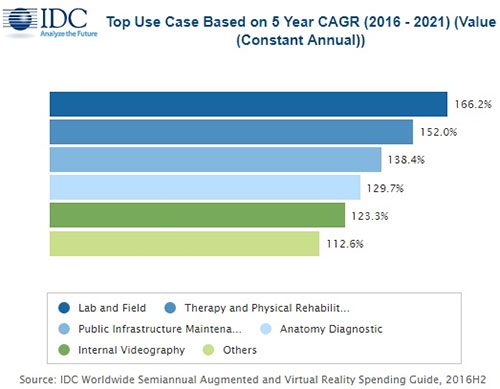The sight of employees toiling away with augmented or virtual reality (AR/VR) gear strapped to their faces will become increasingly common over the next few years, according to a new forecast from IDC.
In 2021, the worldwide sales of AR and VR solutions will reach $215 billion predicts the technology research firm, a lofty amount compared to the estimated $11.4 billion the industry is poised to rake in this year. During the forecast period, which stretches from 2016 to 2021, the market will more than double each year, achieving a compound annual growth rate (CAGR) of over 113 percent.
For now, game- and entertainment-focused solutions for consumers rule the market. But over time, the industry is expected to start putting work before play, at least in the U.S.
This year, demand from the discrete manufacturing and process manufacturing segments will follow the consumer space. In Asia-Pacific (excluding Japan), retail and education will follow the consumer segment.
Looking ahead, process and discrete manufacturing, government, retail, construction, transportation and professional services will all pull ahead of consumer spending in the U.S. by 2021. Consumers are expected to continue to drive the market in Asia-Pacific (excluding Japan) and Western Europe throughout IDC’s forecast.
“Augmented and virtual reality are gaining traction in commercial settings and we expect this trend will continue to accelerate,” said Tom Mainelli, program vice president of Devices and AR/VR at IDC, in a statement. “As next-generation hardware begins to appear, industry verticals will be among the first to embrace it. They will be utilizing cutting-edge software and services to do everything from increase worker productivity and safety to entice customers with customized, jaw-dropping experiences.”
Lab and field implementations that allow users to conduct research and run experiments, will be the fastest growing use case for AR/VR with a CAGR of over 166 percent, said IDC. Therapy and physical rehabilitation (152 percent) and public infrastructure maintenance (138 percent).
The top money-making commercial use case in 2017 will be retail showcasing, generating $442 million in revenue for AR/VR vendors. On-site assembly and safety takes second place with $362 million, followed by training in manufacturing environments with $309 million.
Retail showcasing will fall to third place in 2021 ($3.2 billion), succumbing to increased demand for solutions that aid in industrial maintenance ($5.2 billion) and help communities keep up their public infrastructure ($3.6 billion).
These figures can’t hold a candle to the consumer space. Driven by AR and VR games, worldwide consumer spending will reach $9.5 billion in 2021, anticipates IDC.
Pedro Hernandez is a contributing editor at Datamation. Follow him on Twitter @ecoINSITE.



